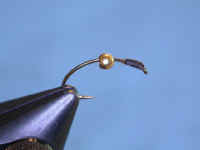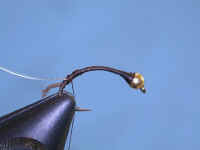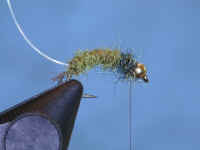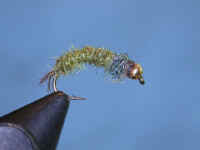|
Fly of
the Month
Bob Ireton brings together his
experience in fly fishing, aquatic entomology, and knowledge of fly
tying techniques and materials, to design and tie durable and
effective flies.
|

|

Volume 4, Issue 6
June 2003

BEAD HEAD CADDIS LARVA
Fly,
Text, and Photography by Bob Ireton
Of the four stages of the caddis fly, (egg,
larva, pupa, and adult), I think the larval stage offers the best chance
of being eaten by a fish. The pupal stage would be a close second. The
larval caddis of most interest to the flyfisher would be the free living,
the net spinners, and the case builders, in that order. Of these three,
fish will see more free-living caddis larva. They are widespread and
abundant in the riffles and runs of freestone streams with high water
quality. If you have seen or done any stream sampling, this is the critter
you see a lot. I've seen mostly the green variety, sometimes called the
green rockworm, but they are also tan. They are well equipped for life in
this environment. The thorax has six strong legs, and there is a pair of
claws, or anal prolegs, on the end of the abdomen. Some caddis larva are
predacious.
The pattern featured here is the 'green
rockworm' variety of caddis larva. The adults are pretty much uniform in
size. The body is slim, but it ties and fishes better on a little larger
size hook. When using this type of synthetic dubbing, I think a loop works
better than just spinning the dubbing around a single thread. I tied using
8x thread to help keep the body compact. Feel free, however, to try your
own variations.
MATERIAL LIST
Hook - Daiichi 1130, Dai-Riki 135,
Gamakatsu C12, Mustad 80250BR, Orvis 1639, TMC 2487
Size - 12
Bead - Gold 3/32
Thread -8/0 Brown
Prolegs - Brown working thread
Rib - 2x tippet material
Abdomen - Light olive 'Mottled Nymph Blend'
Thorax - Peacock 'Mottled Nymph Blend'
TYING STEPS - click
on pictures for larger view
| 1 - Thread the bead onto
the hook by holding the bead in one hand between thumb and fore
finger, with the smaller size hole facing up. Holding the hook with
a pair of tweezers, place point of hook into the smaller hole in the
bead, and continue moving hook point through bead till it is well
onto hook shank. Now move bead rest of way to behind eye of hook.
Pinch down barb of hook, if desired, and place the hook properly in
vice. Slide the bead rearward to midway of hook shank. Attach the
thread behind eye of hook, and lay on a base the length of two bead
diameters. Continue laying on thread back and forth, building up the
base till the bead has almost a snug fit. Tie a half hitch, and then
top the base with a whip finish. Cut off working thread.
|
 |
| 2 - Put some head cement
on the thread base, and work the bead onto the thread till it is
touching the hook eye. Reattach the working thread behind the bead,
leaving about two inches of thread on the tag end to use for the
prolegs. Wrap the thread around the hook behind the larger hole on
the backside of the bead till the hole of the bead is covered. Make
the thread in this area sloping rearward like a short ramp. Continue
rearward, over the tag end of thread, stopping well behind the hook
barb. Take the tag end of the thread, and form a horizontal loop
extending rearward past the working thread. Secure this loop with
the working thread, and tie a half hitch. Cut and trim the end of
the loop to form the prolegs. |
 |
| 3 - Take a piece of the 2x
tippet and flatten the end with plires. By doing this, the tippet
material will attach to the hook shank flatter and more securely
than if you did not do this step. |
 |
| 4 - Hold the flattened end
of the ribbing material against the top of the hook shank, and far
enough up from the end to allow for one wrap of the abdomen to be
behind the rib. Tie in the ribbing, and tie a half hitch or two. |
 |
| 5 - Bring the thread
behind the ribbing, and form a dubbing loop. Place the dubbing for
the abdomen in the loop, with the amount of dubbing material
starting sparser at the top, and increasing as it goes down the
loop. This will cause a tapered body to be formed. Bring the working
thread forward, stopping with space for a thorax. Tie a half hitch.
|
 |
| 6 - Spin the dubbing loop
to make the dubbing rope, then palmer it forward, with the first
wrap behind the attached rib. Stop where you tied off the working
thread, and tie off the dubbing rope with several wraps. Snip off
the tag end of the dubbing rope, and tie a couple of half hitches. |
 |
| 7 - Make another dubbing
loop, and using the thorax dubbing, form the thorax. Tie off, trim
the tag as before, and do a couple of half hitches. |
 |
| 8 - Palmer the ribbing
forward to give a segmented look, and tie off behind bead. Trim the
tag end of the ribbing, and form a thin head behind the bead with
the working thread. Tie a half hitch and a whip finish, and put some
head cement on the thread wraps. Pick out the dubbing a little under
the thorax to give the impression of legs, and any other finishing
touches you would like. |
 |

The Buckeye United Fly
Fishers, Inc is a non-profit corporation organized under section 501(c)(3)
of the Internal Revenue Code, incorporated in the State of Ohio for the
preservation, conservation and wise use of our fishing waters and game
fish; and to assist in the protection and improvement of our natural
resources
|

![]()
![]()
![]()







